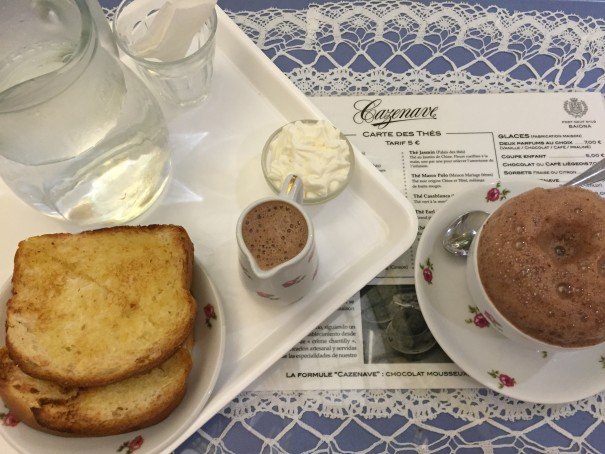
Milk, Bread, Butter, Chocolate

Milk, Bread, Butter, Chocolate
Chocolat Toast in Bayonne
It was one of my more notable detours in a lifetime of impractical diversions on the road. Last summer, I took a long side trip on the way from Lourdes to the airport in Biarritz and stopped in Bayonne, a riverside city in the Pays Basque, just inland from the glittering beaches of the Atlantic coast. Good sense would have dictated that I fly out of Pau, which was much closer. Plus, I was not eager to pass through hordes of chi-chi vacationers inching through traffic on the Côte Basque, of which Biarritz was the de facto capital.
But this was no ordinary deviation, late as I was for the 8 pm flight to Paris. I could anticipate the regret, the what-ifs, the self-recriminations that were all but certain to cascade over me if, because of some foolish airplane reservation, I lost my chance to pull over for Chocolat Toast at Cazenave.
Every great food city has its emblematic dish: Singapore has chili crab, New Orleans has beignets, Brussels has moules frites. The singular aspect of Chocolat Toast, though, is that this signature, utterly Bayonnais concoction is served only at Cazenave, a family-owned shop on the rue Port Neuf.
It’s construction is simple: a cup of foamy hot chocolate as thick as Greek yogurt with a stalagmite of whipped cream on the side, two slices of buttered brioche toast and a generous pitcher of ice water (presumably to cut the blood fats swirling around after ingesting this achingly rich combination). Served at breakfast, at l’heure du thé, or right before closing time to post-miracle pilgrims from Lourdes craving the earth’s most glorious comfort food and who give no damns about missing their flight, the Chocolat Toast ritual is perhaps the sole obligation of the visitor to Bayonne. “People often stop here because it’s a tradition, which is both because of Cazenave itself and also because of the history of chocolate in Bayonne,” says owner Pantxoa Bimboire.
As his name indicates, he is a child of the Basque country, whose grandmother had been a waitress at the salon de thé in the rear of the chocolate shop and who, in 1930, convinced her husband to sell his jewelry store and buy Cazenave. Even then, a tray laden with Chocolat Toast was the iconic dish of this small city on the banks of the Nive and Adour Rivers, the ancestral home of the cocoa bean in France, which had journeyed there from Spain.
While he was decimating the local population, the Spanish conquistador Hernan Cortés saw economic value in the drink the Aztecs called xocolatl, which revved Emperor Montezuma’s troops for battle. Cortés appropriated Mexico’s cacao plantations, and in 1524, the first beans arrived in Spain. Soon the addition of sugar, vanilla, and cinnamon rendered sweet flavor to the medicinal liquid brew and the drink became all the rage throughout Europe’s royal courts.
But in Spain, the chocolate trade was run chiefly by Sephardic Jews, and during the Inquisition, they were forced to flee for Portugal. Again, they were swiftly expelled before finding refuge in the Saint-Esprit quarter of Bayonne, where they brought the tools and know-how of the cocoa trade to France. Soon, another ignoble chapter: In 1761, an ordinance created by Catholic chocolatiers barred Jews from working in the chocolate industry. The Bordeaux parliament annulled this decree in 1767 and by 1854, there were 34 chocolate makers in Bayonne. This is the year that Cazenave opened its doors in the storefront where it remains today.
The shop window is perhaps a testament to Pantxoa Bimboire’s heritage, with plaques of chocolate wrapped in elegant, gem-hued paper. Normally, I’d stop to swoon over the stylish packaging, but it was late that July afternoon, and I had two hours until my plane’s departure. I made my way through the store to the salon de thé. Lined with smoky, century-old mirrors, the tea-room is suffused with Belle Époque glamor, the kind unfortunate restaurateurs in the New World try, pathetically, to fake. To further the sensation of sitting in a jewel box, the room sits under a stained glass dome, milky white and gold, installed in the 19th century.
What is most unchanging is the dish I crave, nearly always, since my first visit to Bayonne thirty years ago. There is nothing terribly complicated about the recipe. Yes, the chocolate tablets from Costa Rica or Venezuela are now organic, but the hot milk poured over them are still from cows who pasture in the lush Pays Basque, as is the cream for the dense Chantilly. The brioche toast is sliced from a special golden loaf, created by a local baker only for Cazenave. Most unusually, the foam that provides a tantalizing lid to the sweet hot chocolate is still whipped by hand using a wooded mousseuse—beater—fashioned from boxwood. “It will always be the same, because this is the heritage of Bayonne,” says Bimboire, who will soon hand over the store to the fourth generation.
And, I learn, it is somehow my heritage, too. This summer day, in this tearoom, making a beeline for what will sustain me: milk, bread, butter, chocolate, comfort.